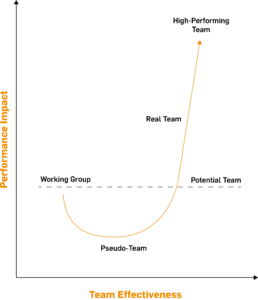In 1992 Jon Katzenbach and Douglas Smith published a book, ‘The Wisdom of Team’s. The pair, both management consultants, have published extensively on organisational performance and change management. Their book is based on talking to hundreds of people on more than 50 different teams in 30 companies and beyond, from Motorola and Hewlett-Packard to Operation Desert Storm and the Girl Scouts.
Do you have a “team” or a team?
Katzenbach and Smith take issue with the description of many of the units they observed as “teams”, arguing that many are just organisational groupings of staff which you might call “working groups”. Now, it is not to say that every group of individuals working together should always be a “team”. In fact, there are many occasions when a working group is apt, committees, councils, and task forces for example are not necessarily needed to be teams.
The issue with the title of “team” is that it is used as a motivating label to force a team into being, rather than fostering the environment and creating the conditions for a real team to develop. Teams are not put together; they develop over time.
It is therefore an important area of clarity that when trying to create teams within our organisations, we need to be aware of the maturity journey. Here, Katzenbach and Smith’s research comes into its own. They wanted to discover what differentiates various levels of team performance and where and how teams work best.
How to identify a team
The first question to answer is, what is a team?
“A team is a small number of people with complementary skills who are committed to a common purpose, set of performance goals, and approach for which they hold themselves mutually accountable.”[1]
A simple and clear definition.
But it is useful to look at the characteristics of a team in a little more depth. Katzenbach and Smith suggest that real teams have very particular characteristics. And before assessing what type of team you have, it is important to find out if you have a team at all or if in fact you have a working group. Not all groups are teams and here’s how to tell the difference:
Working Group
- Strong, clearly focused leader
- Individual accountability
- The groups purpose is the same as the broader organisational mission
- Individual work-products
- Runs efficient meetings
- Measure its effectiveness indirectly by its influence on others e.g, financial performance of the business
- Discusses, decides and delegates
Team
- Shared leadership roles
- Individual and mutual accountability
- Specific team purpose that the team itself delivers
- Collective work-products
- Encourages open-ended discussion and active problem-solving meetings
- Measures performance directly by assessing collective work-products
- Discusses, decides and does real work together
One of the observations Katzenbach and Smith made was that there are varying degrees of team work which they categorised into 5 levels. They recognised that real teams produce a performance dividend compared to the co-ordinated effort of individuals. The graph below shows the relative performance impact of teams at each level.
We have developed a questionnaire to help teams identify their current operating level. Take the teamwork questionnaire, answering “yes” or “no” to each of the questions. If the responses to a team level are majority “yes” that is a good indication of what level your team is operating at.
The Teamwork Questionnaire:
Level 1 Working Group
- Do the team members come together only to share information for the purposes of updating?
- Does the team not have a clear common purpose?
- Does the team have performance goals that do not require mutual accountability?
- Is each team member only accountable for the work that the group has delegated to them?
Level 2 Pseudo Team
- Are team members unwilling to take the risk of committing to a common purpose?
- Are team members unwilling to take on mutual accountability?
- Are discussions often tense and without freedom of expression?
- Is there a lack of a clear performance goal?
Level 3 Potential Team
- Are the team members moving towards a common goal?
- Are there clear performance goals?
- Is the team working towards a higher level of performance?
- Does the team agree on mutual accountability?
Level 4 Real Team
- Does the team share a common purpose and approach?
- Does the team have complementary skills?
- Does the team share accountability for results?
- Is there a drive for the development of the team through the development of the individuals?
In a nutshell, the three deliverables of any team are:
- Collective products and achievements
- Performance results
- Individual growth
And these are achieved via the following 3 factors:
- Commitment – teams are committed when they have goals.
- Skills – team members need problem-solving, technical and interpersonal skills to perform.
- Accountability – team members must have mutual accountability to one another as well as individual accountability to one’s own work.
Moving to high performance
‘High performance teams typically reflect strong extensions of the basic characteristics of teams’.
It is certainly not easy to create a high-performance team with all these qualities, but an organisation can provide the building blocks with a few necessary measures such as the following:
- Setting stretch goals that challenge and inspire performance goals
- Encourage personal initiative and develop individual leadership qualities
- Create a team with the right combination of skills
- Upskill the team – help them develop better work approaches so that they accomplish their tasks in better ways.

